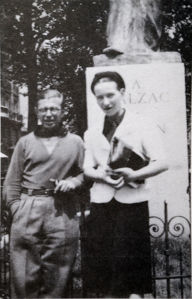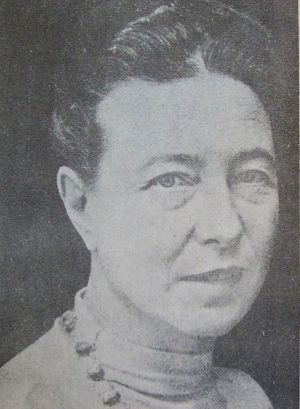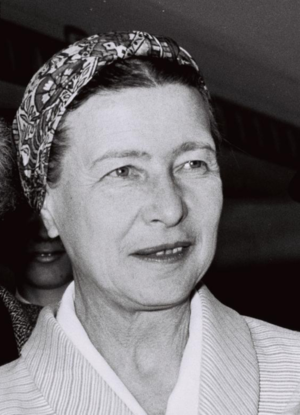| Simone (Bertrand de Beauvoir) de Beauvoir is managed by the France project. Join: France Project Discuss: france |
Contents |
Biography
Simone was a French writer and feminist.
Early Life
Simone Lucie Ernestine Marie Bertrand de Beauvoir was born January 9, 1908 in the 6th Arrondissement of Paris.[1][2] Her parents were Georges Charles Joseph Bertrand de Beauvoir, a legal secretary, and Françoise Marie Thérèse Lucie Brasseur, a wealthy banker's daughter and devout Catholic.[3] Simone's sister, Helene, was born two years later, and was lovingly called "Poupette". The family lost much of their fortune after World War I.[3]

|
| As a young woman |
In Simone's early years, she attended a prestigious convent school. However at the age of 14, she had a crisis of faith and declared herself an atheist.[4] In 1926, Simone attended the Sorbonne, where she studied philosophy and mathematics. In 1929, she passed her aggregation. At the time she was only the ninth woman to graduate from the Sorbonne. It was during these years that she met fellow philosopher Jean Paul Sartre, with whom she would have a lifelong professional and personal relationship.[5][4][3]
Career and Writings
After graduation, Simone taught at a number of schools from 1931-1943. She taught at the Lycée Montgrand in Marseille, Lycée Jeanne-d'Arc in Rouen and Lycée Molière in Paris.[3] Her teaching career ended once she could support herself on her writings alone.
Simone's first major published work was the 1943 novel She Came to Stay in which she examined existential ideals and the complexity of relationships. She followed up the next year with the philosophical essay Pyrrhus and Cineas before returning to fiction with the novels The Blood of Others (1945) and All Men are Mortal (1946).[4]
Simone's seminal work is The Second Sex published in 1949. It is a nearly 1000-page critique of patriarchy and the second-rate status granted to women throughout history. It is one of the most important and earliest works of feminism. It was received with great controversy, with some critics characterizing it as pornography and the Vatican placing the work on the church's list of forbidden texts.[4]
In 1954, Simone published The Mandarins. It won her France's highest literary prize, the Prix Goncourt.[3]
Simone published many autobiographical works including Mémoires d'une jeune fille rangée (1958; Memoirs of a Dutiful Daughter), La Force de l'âge (1960; The Prime of Life), La Force des choses (1963: Force of Circumstance), and Tout compte fait (1972: All Said and Done).[5]
Relationship with Jean-Paul Sartre

|
| With Jean-Paul Sartre |
In 1929 while attending the Sorbonne, Simone met fellow philosophy major Jean-Paul Sartre. Their relationship soon became romantic, but was never conventional. De Beauvoir rejected a proposal of marriage from Sartre since it went against her feminist beliefs. Quote: "Marriage is traditionally the destiny offered to women by society. Most women are married or have been, or plan to be or suffer from not being." Sartre and Simone were partners for fifty-one years until his death in 1980. However, they never lived together and Simone took many other lovers, both male and female, throughout their relationship. They never had any children. In 1945, Simone and Sartre founded and edited "Les Temps Modernes", a monthly review. Simone remained an editor until her death.[3]
Death

|
| Her gravestone |
After Sartre's death in 1980 Simone befriended Sylvie Le Bon, a young student in philosophy. Sylvie became her adoptive daughter and heiress of her literary work and all her possessions. Simone passed away April 14th, 1986, in 14th arrondissement, Paris, France.[2] She was buried on April 16th in Cimetière de Montparnasse, Paris, Île-de-France, France.[6]
Biographie
Débuts
Simone Lucie Ernestine Marie Bertrand de Beauvoir est née le 9 janvier 1908, 103 boulevard de Montparnasse dans le 6ème arrondissement de Paris[1]. Ses parents étaient Georges Bertrand de Beauvoir, avocat, et Françoise Brasseur, fille de banquier et catholique pratiquante[3]. Sa soeur Hélène, affectueusement surnommée "Poupette", naît deux ans plus tard; elle deviendra peintre. Les de Beauvoir perdent la plus grande partie de leur fortune après la Grande Guerre[3].
Simone est éduquée dans un institut catholique prestigieux, mais elle perd la foi à l'âge de 14 ans et se déclare désormais athée[4]. A partir de 1926, elle étudie la philosophie et les mathématiques à la Sorbonne, et obtient l'agrégation en 1929. Elle est alors la 9ème femme a sortir diplômée de la Sorbonne. C'est à cette époque qu'elle recontre le philosophe Jean-Paul Sartre[5][4][3].
Carrière et écrits
Après avoir obtenu son diplôme, Simone a enseigné dans plusieurs établissements entre 1931 et 1943: le lycée Montgrand à Marseille, le lycée Jeanne-d'Arc à Rouen et le lycée Molière à Paris[3]. Elle arrêta d'enseigner une fois que sa carrière d'écrivain lui permit de subvenir à ses besoins.
Sa première oeuvre majeure est le roman L'Invitée, publié en 1943, où elle explore la complexité des relations et les idées existentialistes. L'année suivante elle publie Pyrrhus et Cinéas, un essai philosophique, puis se tourne à nouveau vers la fiction avec les romans Le sang des autres (1945) et Tous les hommes sont mortels (1946)[4].
En 1949 Simone publie Le deuxième sexe, ouvrage fondateur de près de 1000 pages o^ù elle remet en cause le patriarcat et le statut de second ordre attribué aux femmes tout au long de l'histoire. C'est l'un des premiers et plus importants ouvrages féministes. Sa réception est très controversée, certains critiques qualifiant l'ouvrage de pornographique. Le Vatican met le livre à l'index[4].
En 1954, Simone obtient le Prix Goncourt avec Les Mandarins[3].
Simone de Beauvoir a également publié de nombreux ouvrages autobiographiques dont Mémoires d'une jeune fille rangée (1958), La Force de l'âge (1960), La Force des choses (1963), et Tout compte fait (1972)[5].
Relation avec Jean-Paul Sartre
Simone de Beauvoir a rencontré Jean-Paul Sartre en 1929 à la Sorbonne. Ils nouent rapidement une relation amoureuse qui ne sera jamais conventionnelle. En 1931, de Beauvoir rejette la demande en mariage de Sartre. Sartre et Simone sont resté partenaires pendant 51 ans, jusqu'à la mort de Sartre. Ils ne se sont pas mariés, n'ont pas eu d'enfant et n'ont jamais vécu ensemble. Simone a eu de nombreuses liaisons avec des hommes et des femmes tout au long de leur relation.
En 1945, Simone de Beauvoir et Sartre ont fondé la revue mensuelle "Les Temps Modernes", que Simone a continué d'éditer jusqu'à sa mort[3].
Mort
Après la mort de Sartre, en 1980, Simone se lie avec Sylvie Le Bon, étudiante en philosophie. Elle en fait sa fille adoptive et son héritière. Simone est morte le 16 avril 1986 à Paris (14ème arrondissement)[2]. Elle a été enterrée auprès de Sartre, au cimetière de Montparnasse à Paris [6].
Sources
- ↑ 1.0 1.1 acte de naissance Archives du Paris, VI arrondissement, 1908, pg. 15; viewed Nov. 14, 2018
- ↑ 2.0 2.1 2.2 [1] acte de décès, Archives of Paris, 14th Arrondissement, 1986: April 3-May 7, pg. 13; viewed March 5, 2018
- ↑ 3.00 3.01 3.02 3.03 3.04 3.05 3.06 3.07 3.08 3.09 3.10 3.11 [2] Wikipedia: Simone de Beauvoir
- ↑ 4.0 4.1 4.2 4.3 4.4 4.5 4.6 4.7 [3] Biography.com: Simone de Beauvoir
- ↑ 5.0 5.1 5.2 5.3 [4] Britannica: Simone de Beauvoir
- ↑ 6.0 6.1 Find A Grave, database and images (Find A Grave: Memorial #1162 : accessed 13 February 2017), memorial page for Simone de Beauvoir (1908 - 1986) - Find A Grave Memorial.
See also:
- Wikipedia: Simone de Beauvoir
- Wikidata: Item Q7197

No known carriers of Simone's ancestors' DNA have taken a DNA test.
Have you taken a DNA test? If so, login to add it. If not, see our friends at Ancestry DNA.
Featured National Park champion connections: Simone is 24 degrees from Theodore Roosevelt, 27 degrees from Stephanus Johannes Paulus Kruger, 26 degrees from George Catlin, 25 degrees from Marjory Douglas, 32 degrees from Sueko Embrey, 26 degrees from George Grinnell, 31 degrees from Anton Kröller, 25 degrees from Stephen Mather, 29 degrees from Kara McKean, 26 degrees from John Muir, 16 degrees from Victoria Hanover and 32 degrees from Charles Young on our single family tree. Login to find your connection.
B > Bertrand de Beauvoir | D > de Beauvoir > Simone Lucie Ernestine Marie (Bertrand de Beauvoir) de Beauvoir
Categories: Authors | Philosophers | France, Notables | France, Featured Connections | Écrivains | Feminists | Secondary School Teachers | 6e Arrondissement, Paris | Cimetière du Montparnasse, Paris, France | Example Profiles of the Week | Prix Goncourt | Notables






We're featuring Simone on the 9th. If you have anything you'd like to add or any improvements to make to bring it up to WikiTree Style standards, now's the time to do so. I will be going over the profile to do the same in the next week.
(Note to say, she looks pretty nice already)
Abby